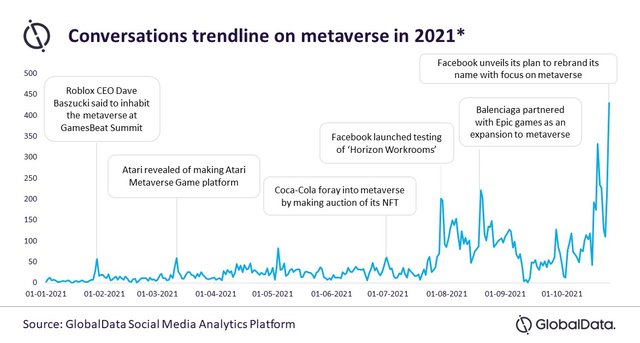"Metaverse" Virtual Reality Is About To Take Over The World And Land You A Six-Figure Salary!

Everyone's attention is drawn to the "$30 trillion" metaverse.
The metaverse is successfully following the web's emphasis. It is a 3D virtual environment in which customers may interact with their surroundings, including other clients.
Aside from providing entertainment, the metaverse is depended on to create its own vast ecosystem. According to Matthew Ball, CEO of investment firm Epyllion, the metaverse is a "$10 [trillion] to $30 trillion open door that will materialize in 10 years or a decade and a half."
A $30 trillion hanging carrot is all that is required to get financial investors excited about the metaverse. Nonetheless, the essential question is: Who will be behind the formation of the metaverse, whether corporations, groups, or individuals?
On the one hand, Meta Platforms (NASDAQ:FB), the entity formerly known as Facebook, spent $10 billion on metaverse-related businesses last year and intends to invest even more in the coming years. Meta is the company behind the well-known Oculus computer-generated reality devices. Given the organization's vast resources and impressive earnings, it stands a real chance of becoming a key player in the metaverse.
However, financial backers have seen a small number of digital forms of money that are involved in the creation of a decentralized metaverse. Putting the destiny of the metaverse in the hands of clients has sent financial backers fleeing into the three cryptographic kinds of money that have accompanied it.
The Sandbox
How insatiable has the appetite for metaverse-centered advanced monetary forms been? The Sandbox (CRYPTO:SAND) has been one of the top-performing digital currencies since the beginning of 2021, with a growth over 13,000 percent as of January 14.
What makes The Sandbox and other decentralized blockchain-based game platforms so appealing is their complete 180-degree abandonment of traditional gaming. Despite the fact that game creators on control center or PC-based gaming are responsible for manifestations, The Sandbox allows customers to own their manifestations as non-fungible tokens (NFTs).
A NFT provides clear evidence of ownership to a digital resource stored on blockchain. As a result, blockchain-based gaming is a potent play-to-acquire gadget that will undoubtedly draw customers.
The Sandbox is a pay-to-win game built on the Ethereum (CRYPTO:ETH) network. SAND, the game's primary currency, may be used to acquire computerized plots of land, as well as to purchase in-game items or redo a sign. SAND tokens may also be marked to earn quick money, which might be more SAND tokens or other types of tokens required for resource development (resources in the game incorporate things like individuals, creatures, and devices).
The Sandbox gives clients a variety of options for customizing their manifestations, including leasing their computerized resources, creating games on their advanced terrains, gaining awards by messing around on other clients' properties, and, in any case, selling resources in an advanced commercial center.
Decentraland
Decentraland is another metaverse digital currency that financial supporters simply cannot get enough of (CRYPTO: MANA). Since the beginning of 2021, financial backers holding the key token (MANA) have "as it were" been paid with profits of about 3,500 percent.
To avoid sounding overly redundant, Decentraland is built on the Ethereum blockchain, with clients interacting in a virtual environment in light of enhanced land ownership. LAND is the NFT that describes responsibility for land on Decentraland, despite the fact that MANA is the stage's key emblem
The game is always evolving to add new client connections and activities that encourage clients to work out their property as well as visit various clients across the game. Decentraland clients, like The Sandbox, may customize their LAND tokens, which are valued in MANA, by selling them in a commercial center or trading them through in-game associations.
This methodology is appealing since Decentraland's product updates are carried through clever agreements (i.e., conventions that check, work with, and uphold the exchange of an agreement). As a result, these updates enable MANA holders to make decisions on prospective approach adjustments. As a result, clients genuinely have a voice in the task's future direction.
Axie Infinity
Axie Infinity is a third metaverse digital currency that financial backers just can't stop buying (CRYPTO:AXS). It has been the top performer among the three computerized monetary standards reported here since the beginning of 2021, with an increase approaching 14,000 percent.
To round off the trifecta, Axie Infinity is also built on the Ethereum blockchain. In any case, when compared to The Sandbox and Decentraland, its interaction provides an unanticipated level of participation. Clients gather, raise, rear, redesign, and battle animals called Axis in this play-to-acquire game. A client needs three Axies before they may conduct a battle, with the victor receiving experience points that can be used to upgrade various aspects of their Axies.
Axie Infinity has completely dominated its competitors in terms of decentralized application (dApp) convention revenue. According to Token Terminal | Fundamentals for Crypto, Axie Infinity has earned $1.18 billion in dApp convention income over the next 180 days (through Jan. 14). This is second only to Ethereum, which generated $5.71 billion in dApp convention revenue during the same time period.
Given that financial supporters have a strong tendency to underestimate the acceptance of new invention, it's extremely possible that these metaverse digital forms of money would misfire a little after such heavenly profits. On the other hand, when academics are dangling a $30 trillion carrot, there's no disputing the metaverse's capabilities.